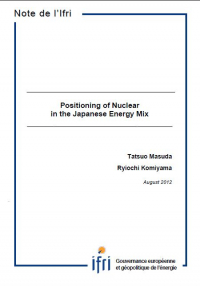Gateway to Think Tanks
| 来源类型 | Publications - Policy Papers |
| 规范类型 | 简报 |
| DOI | 978-2-36567-072-2 |
| Positioning of Nuclear in the Japanese Energy Mix Notes de l'Ifri, October 2012 | |
| Tatsuo MASUDA, Ryiochi KOMIYAMA | |
| 发表日期 | 2012-08-30 |
| 出版年 | 2012 |
| 概述 | Nuclear fission was discovered in the late 1930s. The first application went towards military use, and gradually expanded to civil use such as power generation. Power generation gained importance in two stages: firstly, to shift away from oil in power generation after the oil shocks in the... |
| 摘要 |
Positioning of Nuclear in the Japanese Energy Mix Notes de l'Ifri, October 2012
Nuclear fission was discovered in the late 1930s. The first application went towards military use, and gradually expanded to civil use such as power generation. Power generation gained importance in two stages: firstly, to shift away from oil in power generation after the oil shocks in the 1970s, and second, to arrest climate change due to CO2-free nature of nuclear power more recently. This typically applies to Japan, which has become the world third largest in nuclear power generation. However, nuclear power is violent by nature, and major accidents of nuclear power plants shook the public confidence in nuclear safety. Japan has been put into such situation in a most radical way due to the Fukushima nuclear disaster of March 2011.  This disaster may have its root causes in the history of nuclear development in Japan. Nuclear scientists failed to take the initiative in peaceful use of nuclear and lost the opportunity of making basic researches prior to the commercial introduction of nuclear power generation. Otherwise, safety issues could have been handled with greater care and “nuclear safety myth” could not have prevailed. Today, the discussion is ongoing on how to position nuclear in the Japanese energy mix. Purely from economic viewpoint, due to the energy reality of Japan, it might be extremely difficult to sustain its economy without nuclear at least in short and medium term. However, the public opinions are divided with the vast majority in favor of zero-nuclear or decreased nuclear dependency. In this context, employing an energy-economic model, an attempt was made to analyze Japan’s power generation mix in 2030 under possible nuclear scenarios and assessed the role of nuclear energy in its energy mix. A technical implication taken form this analysis is that, if intermittent renewables such as solar and wind may largely diffuse in power grid replacing nuclear power, output fluctuation from high penetration level of these energy sources will be comprehensively accommodated by quick load following treatment by natural gas combined cycle, coal-fired power and pumped-storage hydro. Accordingly it will be important to coordinate and optimize multiple measures dynamically, together with technological innovation, for the treatment of the intermittency of renewables. A newly born “energy democracy” in the post-Fukushima era will have impact on the government’s decision on the future energy mix expected early in autumn. Whatever the decision might be, the Japanese energy structure has already started to change towards further energy saving and efficiency. This will ultimately lead to the development of “a new energy model”, which will benefit all over the world.
Positioning of Nuclear in the Japanese Energy Mix
|
| 关键词 | Nuclear Energy Japan |
| URL | https://www.ifri.org/en/publications/enotes/notes-de-lifri/positioning-nuclear-japanese-energy-mix |
| 来源智库 | French Institute of International Relations (France) |
| 引用统计 | |
| 资源类型 | 智库出版物 |
| 条目标识符 | http://119.78.100.153/handle/2XGU8XDN/415658 |
| 推荐引用方式 GB/T 7714 | Tatsuo MASUDA, Ryiochi KOMIYAMA. Positioning of Nuclear in the Japanese Energy Mix Notes de l'Ifri, October 2012. 2012. |
| 条目包含的文件 | ||||||
| 文件名称/大小 | 资源类型 | 版本类型 | 开放类型 | 使用许可 | ||
| masuda.jpg(25KB) | 智库出版物 | 限制开放 | CC BY-NC-SA |  浏览 | ||
| noteifrienergiemasud(2623KB) | 智库出版物 | 限制开放 | CC BY-NC-SA | 浏览 | ||
除非特别说明,本系统中所有内容都受版权保护,并保留所有权利。